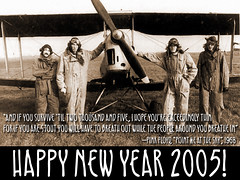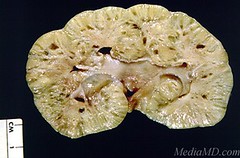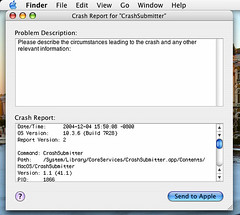Back in 1999 I first became aware that my kidneys had a problem. It started with a hot pain in my back and blood in my urine. I paid a visit to my doctor, and had an x-ray done, then a rather interesting and enjoyable ultrasound, followed up by an MRI scan. The MRI was interesting but unpleasant. Mainly I just remember fasting for the first time ever, the foul-tasting "piña colada" drink loaded with luminous dye that I had to force down just before going for the scan, and then lying on the little gurney, a tube pumping another luminous dye into my veins halfway through the scanning.
In addition to confirming that, yes, I was suffering from kidney stones, the MRI also revealed that I had cysts on my kidneys, particularly my left kidney. The urologist told me that it's common for a person to have a single cyst, but unusual to have cysts all over the kidneys. We talked briefly about a disease called Polycystic Kidney Disease, which is presently incurable, degenerative, and ultimately fatal. Needless to say, this was definitely not news I wanted to hear. The urologist was, however, very reassuring. Since I haven't shown any symptoms of anything the cysts would cause, they couldn't really diagnose the cysts as being anything. Until I experienced some symptoms, he said, I should just put it out of my mind and not worry about it.
I did exactly that. I put the cysts at the back of my mind, and saved my attention and energy for the kidney stones.
I dealt with something like six or ten bouts of kidney stones over the next five years, becoming intimately familiar with the symptoms. One episode was particularly horrible, with intense pain like nothing I could have ever imagined. It literally had me crippled, hunched over moaning and gasping until my wife came home and took me to the emergency room where I was treated to the dreamy painlessness of a morphine drip. I've since been told that passing a kidney stone can sometimes be even more painful than childbirth. I'm sure that particular instance was just such a case. I haven't experienced that level of pain again since then, and hope I never have to.
Sometime back near the start of the summer of 2004—June or July—I started having a strange pain in the left side of my back. It only stood out a little from my usual arthritis pains, and I figured I'd just pulled a muscle or something. No biggie.
Problem is, come September it was still there, and subtly worsening. As I worked on all the campaigning stuff in September and October, it just kept getting worse, to the point where sometimes just turning very slightly would cause a sudden, intense pain to rip through my side. Sometimes it feels as though there's something inside my left side, something jabbing me inside. It had to be a particularly bad kidney stone, I figured, and I only hoped it wouldn't be as painful as the episode which had landed me in the E.R.
During the last week or two before the presidential election, it got to the point where I had to start popping hydrocodones (generic Vicodin) to deal with it. I had a prescription for the pain killers endocet and hydrocodone for when I had particularly bad kidney stone pains. I know pain killers are a popular drug to abuse, but I've always been clean—I don't even drink alcohol or smoke—so I really don't have any interest in abusing those pain killers. But they sure come in handy when the pain gets especially bad.
With the pain severe enough to force me into taking hydrocodone, I quit procrastinating and made an appointment with my doctor. Around the time of the election, the pain got really serious, and didn't go away. It became a constant burning pain, growing and fading but never disappearing altogether. And if I turned or bent to get a paper or something, I often got a sudden flare of pain that makes me actually cry out uncontrollably.
I felt sure that the source must be a bunch of jagged kidney stones that just weren't coming loose and dropping from my kidneys. That's just my wild theory. At times it felt like a cracked the lowest rib on my left side, but it didn't hurt when I touched the rib, which it would if it was broken. (Plus, a broken rib would have healed long ago.)
The night of November 9th, I foolishly let myself doze off right on the carpeted-but-hard floor. I woke up four hours later lying right on the painful part of my left side. D'oh! Needless to say, it hurt like f*ing HELL for several days after.
On November 11th I saw the doctor and got two x-rays taken. I got to see the x-ray plates myself. I saw what looked exactly like two kidney stones. One was about the usual size (about as big as the fingernail on the pinkie finger), but one of them was damn near the size of a walnut! Holy crap, I couldn't believe it was that big...
A couple weeks passed, but no stone passed and the pain just kept on burning, aching, and occasionally stabbing me when I turned or leaned the wrong way. In that time, I had a new MRI done—this time without Satan's favorite drink (that horrible, luminous "piña colada") and without any needles in my arm to inject dye.
On Monday, December 6th I saw the same urologist I had visited in 1999. I fully expected to be told I was experiencing a nasty stone or two, and that they would have to use lasers or sonic frequencies to break it up. I thought that I would ask, if I remembered, whether the cysts had changed.
It didn't turn out to be that simple at all.
I don't have any kidney stones in my system right now. There are a few way up in my left kidney, but they haven't "dropped" yet, which means they're currently not a problem and not the source of the pain. There are no stones in the tracts now. So kidney stones are currently not a problem, and have nothing to do with the bad pain I've been having the last few months.
The MRI turned up that thing which I'd put out of my mind five years earlier: the cysts all over my kidneys. The cysts, the urologist told me, have grown, spread and worsened significantly. These cysts are the origin of the constant pain. They show all the signs of being degenerative, and now the doctor—with clearly apparent surprise himself—said this really looks like PKD.
I'm in line now for a small battery of tests and appointments. This afternoon I'm going for another X-ray, this time with iodine dye to illuminate all the nifty little tubes and veins.I'm going to another kidney specialist soon—this one a renal surgeon, a nephrologist—for further diagnosis. I'm also
I'm not upset or freaked out so much as I'm just shocked and numb. The prognosis doesn't look very good right now, but I'll adapt and adjust no matter what. I'm prepared to accept anything. Or at least I think I am. I'll just take things as they come, and see how well I can ride out the waves.
Later today I have the next x-ray done, including some kind of luminoud dye. Meanwhile, I've found a couple good resources for information about PKD:
The PKD Foundation
The New Zealand Kidney Foundation's fact sheet on Polycystic Kidney Disease
The PKD Access Center



